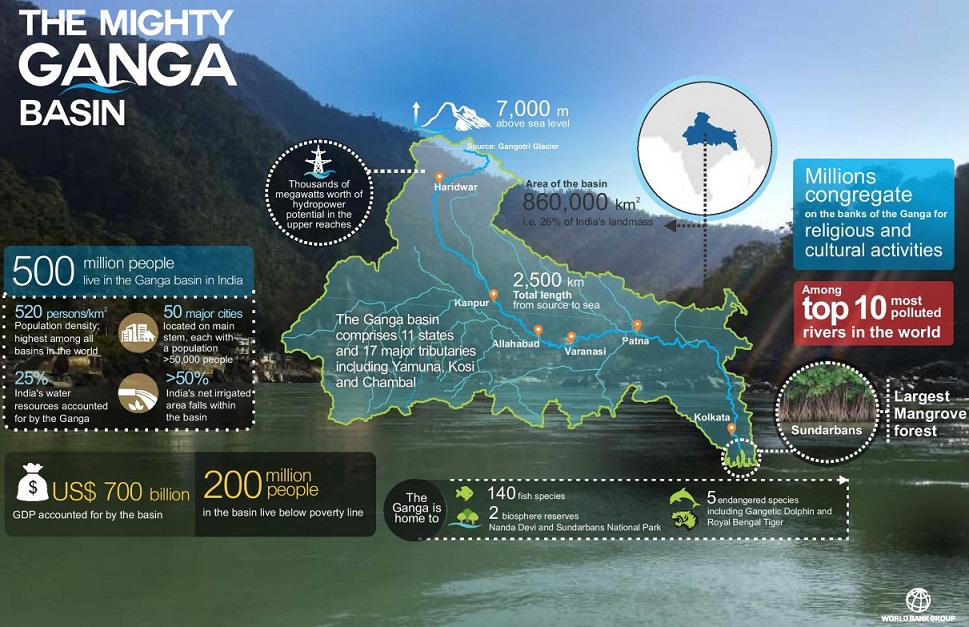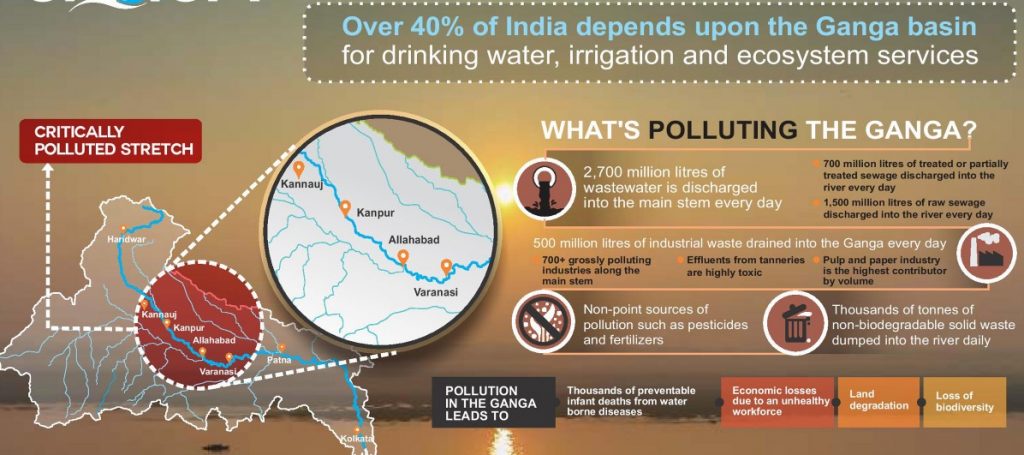Focus: GS-III Environment and Ecology, Indian Economy
Why in news?
The World Bank and the Government of India signed a loan agreement to enhance support for the Namami Gange programme that seeks to rejuvenate the Ganga river.
Details
- The Second National Ganga River Basin Project will help stem pollution in the iconic river and strengthen the management of the river basin which is home to more than 500 million people.
- The World Bank has been supporting the government’s efforts since 2011 through the ongoing National Ganga River Basin Project, which helped set up the National Mission for Clean Ganga (NMCG) as the nodal agency to manage the river, and financed sewage treatment infrastructure in several riverside towns and cities.
Ongoing National Ganga River Basin Project:
- National Ganga River Basin Project is helping the National Ganga River Basin Authority (NGRBA) build institutional capacity for rejuvenating the river.
- It is also financing key infrastructure investments in the five mainstem states – Uttarakhand, Uttar Pradesh, Bihar, Jharkhand and West Bengal.
The Ongoing project has:
- Helped set up the National Mission for Clean Ganga
- Helping build sewage collection and treatment infrastructure in 20 towns along the mainstem of the Ganga
- News sewage treatment capacity created and new sewage networks built
- Helped foster public mobilization for Ganga rejunivation
Namami Gange Programme
- ‘Namami Gange Programme’, is an Integrated Conservation Mission, approved as ‘Flagship Programme’ by the Union Government to accomplish the twin objectives of effective abatement of pollution, conservation and rejuvenation of National River Ganga.
- It is an umbrella programme which integrates previous and currently ongoing initiatives by enhancing efficiency, extracting synergies and supplementing them with more comprehensive & better coordinated interventions.
- Namami Gange is implemented by the National Mission for Clean Ganga (NMCG), and its state counterparts—State Programme Management Groups.
National Ganga River Basin Authority (NGRBA)
- National Ganga River Basin Authority (NGRBA) is a financing, planning, implementing, monitoring and coordinating authority for the Ganges River, functioning under the Ministry of Water Resources, River Development & Ganga Rejuvenation (Now Ministry Jal Shakthi).
- The mission of the organisation is to safeguard the drainage basin which feeds water into the Ganges by protecting it from pollution or overuse.
Neither Statutory not Constitutional.
National Ganga Council (NGC)
- Union government had taken decision under River Ganga (Rejuvenation, Protection and Management) Authorities Order 2016 for a new body named “National Council for River Ganga (Rejuvenation, Protection and Management)” NCRG to replace existing NGRBA.
- NGC would have on board the chief ministers of five Ganga basin states—Uttarakhand, Uttar Pradesh (UP), Bihar, Jharkhand and West Bengal—besides several Union ministers and it was supposed to meet once every year.
Neither Statutory nor Constitutional.
National Mission for Clean Ganga (NMCG)
- National Mission for Clean Ganga (NMCG) was registered as a society on under the Societies Registration Act 1860.
- The government had set up the Clean Ganga Fund in 2014 – Using the funded money to finance NMCG (National Mission for Clean Ganga 2011), cleaning the river, setting up Waste Treatment Plants, Conservation of river biodiversity and related R&D projects.
- NMCG is the implementation wing of National Council for Rejuvenation, Protection and Management of River Ganga (referred as National Ganga Council NGC).
The NMCG now has the status of an Authority and its key focus would be maintaining required ecological flows in the Ganga, abate pollution through planning, financing and execution of programmes including that of –
- Augmentation of Sewerage Infrastructure
- Catchment Area Treatment
- Protection of Floodplains
- Creating Public Awareness
The Union Cabinet has recently approved changes allowing the National Mission for Clean Ganga to fine those responsible for polluting the river, which was vested solely with the Central Pollution Control Board earlier. The power to fine the polluters is derived from the Environment Protection Act.
- It has a two-tier management structure and comprises of Governing Council and Executive Committee, both of the tiers are headed by the Director General (DG), NMCG.
- Similar to structure at national level, State Programme Management Groups (SPMGs) acts as implementing arm of State Ganga Committees. This structure attempts to bring all stakeholders on one platform to take a holistic approach towards the task of Ganga cleaning and rejuvenation.
Need for Ganga Rejuvenation
- The Ganga Basin provides over one-third of India’s surface water, includes the country’s largest irrigated area, and is key to India’s water and food security.
- Over 40 percent of India’s GDP is generated in the densely populated Basin.
- But the Ganga river is today is facing pressures from human and economic activity that impact its water quality and flows.
- Over 80 per cent of the pollution load in the Ganga comes from untreated domestic wastewater from towns and cities along the river and its tributaries.






